Llanbister is a small village at the heart of the historic county of Radnorshire, situated on the A483 main road from Newtown to Llandrindod Wells, at its junction with the B4356 road. At the centre of the village is its Twelfth Century Church, which is dedicated to St. Cynllo. Situated in a prominent position opposite the Church is the village war memorial, in the form of a granite obelisk, which commemorates eight men who fell during the Great War and one who fell during World War Two. The memorial also commemorates the nine local men severely wounded, and the three taken prisoner of war during the Great War.
The Great War, 1914-1918
Philip Llewellyn Davies, Private, 27857, Border Regiment. Philip was the son of William and Ellen Davies, of Lower Green, Llanbadarn Fynydd. He worked on his fathers farm prior to enlisting into the Herefordshire Regiment. He was then posted to the 3rd Battalion, King’s Shropshire Light Infantry, but upon arrival in France was posted to the 11th Battalion, Border Regiment (Lonsdales). The battalion was raised by the Earl of Lonsdale and had been in France since 23 November 1915, attached to 97 Brigade, 32nd Division, moving to the Bouzincourt sector. The division saw its first action during the Battle of the Somme, and after suffering heavy casualties moved to the Cambrin sector to rebuild. It then moved back to the Somme sector in the middle of October 1916 and camped at La Vicogne for several weeks before moving back into the line, marching past Black Horse Bridge, through Engelbelmer and Mailly Maillet to the Redan Ridge sector on 17 November, to take over the front line. At 6.10 the following morning the Lonsdales rose from their trenches and attacked the Germans on Redan Ridge. Philip was killed during the advance that day. He was 33 years old and is commemorated on the Thiepval Memorial, France.
William Davies, Private, 13388, King’s Shropshire Light Infantry. William was the son of Richard and Mary Davies, of Church Villa, Llanbister. He worked as a waggoner prior to enlisting at Merthyr into the 7th Battalion, King’s Shropshire Light Infantry. The battalion was attached to 76 Brigade, 25th Division and William landed with the battalion in Boulogne on 28 September 1915. Two weeks later the entire brigade moved to the 3rd Division at Ypres, and moved into positions near Ploegsteert before moving into trenches in Sanctuary Wood. On 21 October the brigade was relieved and moved to Steenvoorde, then a month later moved to Reninghelst, some ten miles behind the front line which the division had been allotted. The weather was terrible and many men became ill, suffering frostbite and trenchfeet also. During February the brigade took part in heavy fighting at The Bluff, following the Germans exploding mines beneath the front line. This was a terrible period for the men at Ypres, with relentless fighting and the awful conditions making their lives a misery. William was killed in action during one of these tours in the front line, on 31 March 1916, aged 24. He is buried in Dickebusch New Military Cemetery, Belgium.
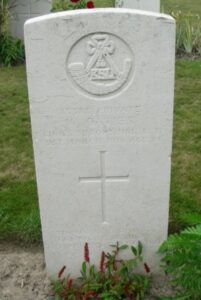
Edward Price Hardwick, Private, 231018, King’s Shropshire Light Infantry. Edward was the son of James and Margaret Hardwick, of Cillybyddir, Llanbister Road. He worked as a waggoner at Little Moelfre prior to enlisting at Knighton into the King’s Shropshire Light Infantry and landed in France on 22 September 1915, before being posted to the 1st KSLI, which was attached to the 6th Division at Ypres. He was probably wounded at some time, either during the Somme offensive in 1916 or at Ypres in 1917, as he returned to Britain before being re-posted to the 10th Battalion, KSLI, which was attached to 231 Brigade, 74th (Yeomanry) Division. The division had moved to France on 7 May 1918 following service in Egypt and Palestine. It took up the line in Flanders, between the La Bassée Canal and the River Lys. By now there was a lull in the fighting. The Germans had expended all of their energy during their offensives on the Somme and along the Lys valley, and were focusing on the Aisne sector, so the 74th Division had time to settle into the alien conditions, after three years in the desert. On 4 August the Germans began retiring from the Lys sector and the 74th Division warily began to advance. On 22 August 231 Brigade was ordered to co-operate with an advance by the Brigade on its left, and on the following day the 10th KSLI were counter-attacked by the Germans, suffering three officers and forty-one other ranks killed or wounded. Edward was among those wounded during the fighting which followed, and he died of his wounds on the following day, 23 August 1918. He was 29 years old and is buried in Aire Communal Cemetery, France.
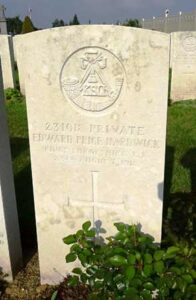
Thomas Jones, Private, 55244, Royal Welsh Fusiliers. Thomas was the son of Richard and Sarah Jones, of Cefncledryn, Llanbister. He worked at Great Cwmllechwedd Farm, Llanbister Road prior to the war. Thomas enlisted at Welshpool into the Montgomeryshire Yeomanry, and after training was posted to France, joining the 2nd Battalion, Royal Welsh Fusiliers. The battalion had been in France since 11 August 1914 and on 22 August had been attached to 19 Brigade. The brigade became attached to the 6th Division on 12 October 1914, then moved to the 27th Division, then the 2nd Division and to the 33rd Division on 25 November 1915. Thomas would have joined the battalion at some time in 1916 and would most likely have taken part in the division’s attacks on the Somme later that year. By the spring of 1917 the division was at Arras and took part in heavy fighting on the Hindenburg Line and at Bullecourt, before being moved to the Flanders coast, for an operation that did not materalise. It was then moved to the Ypres sector on 15 September 1917, to take part in the Third Battle of Ypres. Thomas was killed soon after, on 24 September 1917, when the 2nd RWF were in the line in front of Polygon Wood, preparing to launch an assault alongside the Australians. The 21-year-old has no known grave and is commemorated on the Tyne Cot Memorial, Belgium.
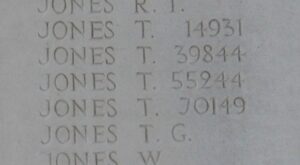
William James Lewis, Private, 2707, Montgomeryshire Yeomanry. William was the son of Mrs Margaret Davies, of Pentwyn, Llanbister Road. He worked at White Walls Farm prior to enlisting into the 2/1st Battalion, Montgomeryshire Yeomanry. William served for less than six months on home service before taking ill, and died of bronco pneumonia at Llanbister on 11 April 1915, aged 19. He was buried in Hephzibah Baptist Chapelyard, Llanbister.
Pryce Mytton Owens, Private, 2567, Montgomeryshire Yeomanry. Pryce was born in Penyffynon, Llanbister in 1888. He had lived and worked at Cwm-y-Gaist, near Llangunllo prior to enlisting into the 2/1st Battalion, Montgomeryshire Yeomanry soon after the outbreak of war. He was posted with the battalion to Dorchester, where it was part of the 2/1st South Wales Mounted Brigade, and in September 1915 moved to Southwold, for coastal defensive duties. On 15 March 1916 Pryce was assisting the regimental quartermaster with a delivery of hay for the battalions horses. Pryce had finished unloading and while dismounting from the hay-cart one of the horses was startled and bolted. Pryce tried to jump on the saddle of one of the horses, but fell and was kicked in the head by one whilst being dragged behind. The tragedy was widely reported in the local newspapers. The 28-years-old was buried with full military honours by the Reverend J. Handingham and the Reverend Powell, Chaplain to the Welsh Brigade, at St. Edmund’s Churchyard, Southwold, and the Last Post was sounded over his grave.
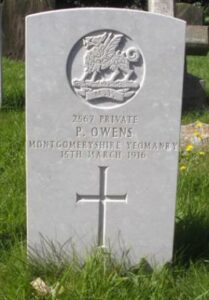
John Abraham Price, Private, 235762, Royal Welsh Fusiliers. John was the son of James and Margaret Price, of Bryngwyn, Llanbister. He worked on his fathers farm prior to enlisting into the Montgomeryshire Yeomanry soon after the outbreak of war. He was posted to France, originally joining the 4th Battalion, Royal Welsh Fusiliers, but was soon transferred to the 9th Battalion, Royal Welsh Fusiliers. The battalion was attached to 58 Brigade, 19th (Western) Division and had taken part in several major battles since moving to France in the summer of 1915. During the autumn of 1917 the division had been at Ypres, and saw heavy fighting at Passchendaele. By the spring of 1918 the division had moved to the sector at Bealencourt, facing the Hindenburg Line and was preparing for the German offensive, which the Allies had anticipated. At dawn on 21 March the Germans launched the first of their three offensives in 1918, on the Somme and the 19th Division became caught up in heavy fighting during an epic rear-guard action. The division had been pushed back to Sailly-au-Bois by the time it was relieved by the Australians and was transferred to the Lys sector, around Messines Ridge, to rest. On 9 April the Germans launched their second offensive, this time along the Lys Valley, and the 19th Division was caught up in the thick of the fighting once again. After a week of desperate fighting, the 19th Division had been pushed back and was behind Mount Kemmel, in reserve. The Germans launched a fierce assault on Mont Kemmel on 16 April and the 19th Division was ordered forwards to man the reserve line. John was killed in action on 18 April 1918, when the 19th Division was readying to face the grey storm of the Germans again. The 25-year-old has no known grave and is commemorated on the Tyne Cot Memorial, Belgium.
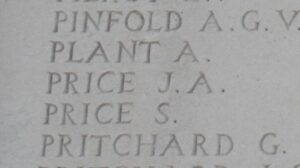
Evan Richards, Private, 34251, King’s Shropshire Light Infantry. Evan was born at Brynwhidoes, Llanbister in 1899, the son of Edward and Jane Richards. The family later farmed at Bailey Farm, Llangynllo. Evan enlisted at Llangynllo into the army and after training was posted to France, joining the 1st Battalion, King’s Shropshire Light Infantry, which was attached to 16 Brigade, 6th Division. He probably joined the battalion late in 1916 after its efforts on the Somme. During 1917 the 6th Division took part in the Battle of Arras, and then fought at the Battle of Cambrai later that year. The division remained in the Cambrai area over the winter and on 21 March 1918 was one of the divisions hit hard by the German offensive. The division took part in heavy fighting as the line was withdrawn over the coming days and upon being relieved moved to the Lys sector. On 9 April the Germans launched the second of their three offensives of 1918, along the Lys Valley. The 6th Division was again caught up in heavy fighting, suffering heavy casualties once more. At some time during this terrible period, Evan had been taken prisoner by the Germans, and was incarcerated in a camp in the Ardennes. He died in Sedan Hospital on 27 August 1918, aged 19, and is buried in Sedan (St. Charles) Communal Cemetery, France.
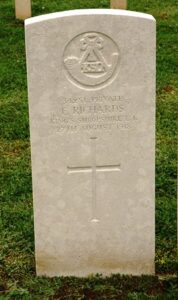
World War Two, 1939-1945
Trevor James Jones, Private, 14676404, Durham Light Infantry. Trevor was born at New Cottage, Llanbister on 25 May 1925, the son of Richard Morgan Jones and Cecilia Eaton Jones (nee Marpole). The family later lived at Llandrindod Wells. Trevor enlisted into the army following the outbreak of war and was posted to the 8th Battalion, Durham Light Infantry. The battalion landed on the Normandy beaches at midday on 6 June 1944, as reserve Battalion of 151 (Durham) Brigade. The troops moved forwards from the beaches towards Meuvaines and saw little resistance. Again the line was advanced on the following day and the 8th Durhams took up positions along the Bayeix to Caen railway. Trevor was killed here when the battalions positions were attacked by Tiger tanks which machine-gunned their trenches on 11 June 1944. He was just 19 years old and is buried in Bayeux War Cemetery, France. The inscription at the base of his headstone reads: ‘DEAREST TREVOR NO MORNING DAWNS NO NIGHT RETURNS BUT WHAT WE THINK OF YOU’.
